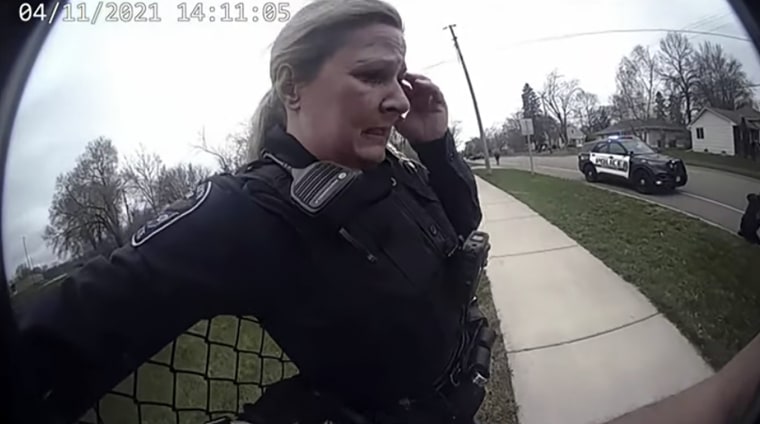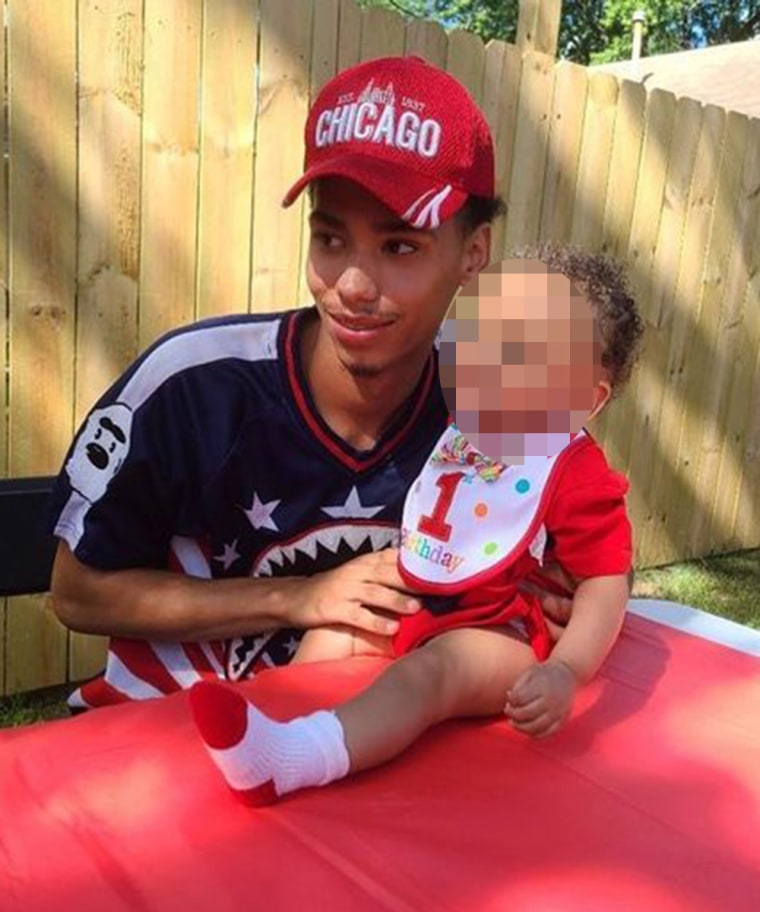Kim Potter, a former officer in Minnesota charged with manslaughter in the death of Daunte Wright, a Black man, sobbed on the witness stand Friday and offered a tearful apology while recalling the "chaotic" moments of the fatal shooting.
The April 11 encounter involving Potter and other officers from the Brooklyn Center Police Department escalated during a traffic stop, she testified, after Wright, 20, was asked to step out of a white Buick.
Potter said she told Wright he had an outstanding warrant. It was for a weapons violation, she said.
Wright, outside of his vehicle and about to be arrested, pulled away from police and tried to get back into his car, Potter said, which prompted a struggle between Wright and then-Sgt. Mychal Johnson.
Potter, a 26-year police veteran, testified that Wright began reaching for the gear shift.
"I can see Johnson's hand, and then I can see his face. ... He had a look of fear in his face," Potter's voice cracked and she began crying. "And it's nothing I've seen before. We were trying to keep him from driving away. It just, it just went chaotic. ... And then, I remember yelling, 'Taser. Taser. Taser.' And nothing happened. And then, he told me, I shot him."
Before the deadly confrontation, Potter testified, police also learned Wright had a restraining order filed against him. Potter said it was her job to figure out if a female passenger in the car with Wright was the woman who was the subject of the order.
Potter, wearing a yellow cardigan and blouse, was called by the defense and began her highly-anticipated testimony in front of her mother, husband and brother, she said.
Potter said while an elementary student, an officer visited her school to talk about bicycle safety. She said that moment left a lasting impression.
"He really influenced me as a youngster that the police were good people and I wanted to be something like that some day," she said.
Potter, 49, who is white, is charged with first-and-second-degree manslaughter. Her attorneys argue she mistakenly fired her handgun, confusing it with a stun gun.
Bodycam video captured when Potter fired once.

The trial began Dec. 8. Prosecutors on Thursday rested their case against Potter.
Potter continued her testimony and said she has never received any complaints of abusing power or complaints from the public. She estimated that training spent on how to use her service weapon, compared with a stun gun, was about 80 percent focused on handgun training.
"We spent a lot more time on firearms than we did on Taser," she said. Potter also said, when questioned, the stun gun she carried was shaped like a gun and also had a dark handle and dark top.
Potter testified that prior to the traffic stop she had never fired a stun gun on duty.
"I would take my Taser out on rare occasion, but I don't believe I ever deployed it."
Her defense attorney asked about previous testimony saying she hadn't tested the stun gun for a couple of days prior to the shooting.
"I don't recall if I would have, or wouldn't have," Potter said.
The defense has called the shooting a horrific mistake, but have also asserted that Potter would have been within her rights to use deadly force because Wright might have dragged another officer, Johnson, with his car.
Potter was questioned by a prosecutor about the differences between a stun gun holster and gun holster, including how a stun gun holster is made of plastic, while the gun holster is leather.
Potter agreed that releasing the weapons from the different holsters required different movements, with a gun holster being released from its holster by rocking the release mechanism forward, while a stun gun is released from its holster by rocking it backward.
While questioned by the state, Potter agreed that although she had never fired a stun gun on duty, she had drawn it and pointed “several times” to de-escalate previous incidents in her career.
Potter’s re-direct testimony was paused at the request of her attorneys, and Judge Regina Chu ordered a lunch break Friday when Potter again began crying while being questioned about her actions during the fatal encounter.
Testimony from Potter after the break was just as emotional.
Prosecutor Erin Eldridge said Potter had testified she didn't remember a lot of her actions leading to Wright's death.
She then brought up what Potter had previously told Laurence Miller, a psychologist and witness paid $30,000 by Potter's defense team as a consultant, who had interviewed Potter about the shooting.
Miller, whose expertise includes the psychological effects on officers of stressful on-duty encounters such as shootings, testified earlier Friday about circumstances that may lead to officers mistakenly reaching for a gun instead of a stun gun.
"Didn't you tell Doctor Miller you remember seeing the gun in your right hand?," Eldridge asked Potter. "You said that, right?"
"I don't remember my interview with him," Potter said. "I was distraught. I wasn't in a good place."
Eldridge then questioned Potter about her reaction captured on video, and everything Potter failed to do after shooting Wright.
Eldridge pointed out how Potter's reaction included yelling multiple expletives, and declaring she grabbed the wrong weapon.
Potter also shouted, "I'm going to go to prison" because she "killed a boy," Eldridge said.
Eldridge then listed police duties Potter neglected to perform. That included failing to check on Sgt. Johnson, or communicate with other officers over radio about what happened. Potter also did not check for injuries following a crash between Wright's Buick and a second vehicle.
Potter agreed with Eldridge's rehashing of events.
"You didn't run down the street and try to save Daunte Wright's life, did you?," Eldridge asked.
"You were focused on what you had done because you had just killed somebody," Eldridge said.
"I'm sorry," Potter said while crying. "I'm so sorry. I'm so sorry."
Eldridge said Potter knew deadly force was unreasonable and unwarranted.
"I didn't want to hurt anybody," Potter said.
Potter stepped down from the witness stand after testifying for about two hours. Chu told jurors witness testimony had concluded and the jury would reconvene on Monday.
Potter's former boss, Timothy Gannon, a defense witness, who testified Thursday he was Brooklyn Center’s Police Chief from September 2015 until April, said he viewed Potter’s bodycam video of the shooting the day it occurred. Gannon also testified he later saw video from a patrol vehicle, which captured the incident from another perspective.
“When I viewed both camera angles, and had all the data in front of me, I saw no violation,” Gannon said. He added the footage showed no violation of “policy, procedure law,” which encompasses use-of-force laws.
In the aftermath of the shooting, Gannon said, political pressures mounted and he was forced “to resign in lieu of termination” because he refused to immediately fire Potter.
Potter resigned two days after the fatal shooting. She posted a $100,000 bond in April and was released from the Hennepin County jail.
Potter’s defense lawyers also called multiple witnesses, many of whom were her former colleagues, who testified about her professionalism and reputation as a peaceful officer.
Also on Thursday, defense witness Stephen Ijames, a former assistant police chief in Springfield, Missouri, testified officers who stopped Wright were legally bound to arrest him after discovering the outstanding warrant.
He also said officers had to assume that Wright “very likely could have a gun” because he had one in the past, and that it would have been a “dereliction of duty” for them not to have tried to arrest him.
Wright was pulled over in the Minneapolis suburb for having expired licensed plate tags and an air freshener hanging from his rearview mirror.
Use-of-force expert Seth Stoughton, a professor at the University of South Carolina School of Law, testified Wednesday for the prosecution that if it appeared Wright was going to drive away, shooting a gun or deploying a stun gun would have made things worse because he could have been incapacitated and his vehicle could have become a weapon.
Earlier this week, testimony focused on the police department’s use-of-force policies and procedures that Potter was required to follow.

Wright’s death occurred while Derek Chauvin was on trial in nearby Minneapolis in George Floyd’s death, which prompted several nights of angry protests in Brooklyn Center.
Brooklyn Center Police Department Commander Garett Flesland testified Tuesday about the department’s use-of-force policies and requirements for candidates, saying officers must take an oath. The policy says an officer’s fundamental duty is to serve the community, and Flesland said, “I believe that’s the core of what we do. We serve and protect.”
He said officers must have the ability to make effective decisions under pressure, and that Potter was aware of the policies even as they evolved over the years.
On Monday, prosecutors put the differences between Potter’s handgun and her stun gun on display for jurors.
Sam McGinnis, a senior special agent with the state’s Bureau of Criminal Apprehension, testified that Potter’s duty belt had holsters that require an officer to take deliberate actions to release the weapons. The gun holster has a snap, while the stun gun holster has a lever. The handgun, which is black, is also twice as heavy as the yellow stun gun, McGinnis said.
Stun guns have different triggers, grips and safety mechanisms, McGinnis testified. He said the weapon also has a laser and LED lights that display before it is fired, which he demonstrated for the jury, while the handgun does not.
McGinnis also testified that Potter didn’t perform a function test on her stun gun at the start of her shift. Although the Brooklyn Center Police Department’s policy is that officers are supposed to do the test, McGinnis acknowledged under cross-examination that he didn’t check to see how widely the department’s officers complied.
After Wright was shot, his car drove away and collided seconds later with an oncoming car. Any injuries from the crash were insignificant in terms of what caused Wright’s death, Dr. Lorren Jackson, an assistant Hennepin County medical examiner, testified Monday.
Jackson also testified that Potter’s bullet caused injuries to Wright’s heart and lungs and those caused his death. He said one can survive such injuries for only “seconds to minutes.” The case is being heard by a mostly white jury.
State sentencing guidelines call for just over seven years in prison upon conviction of first-degree manslaughter and four years for second-degree, though prosecutors have said they plan to push for longer sentences.
